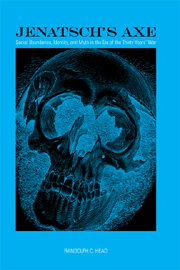Book contents
- Frontmatter
- Contents
- List of Illustrations
- Acknowledgments
- Prologue: Murder (Victim) in the Cathedral
- Introduction
- Chapter 1 A Brief Life of George Jenatsch
- Chapter 2 “Georgius Jenatius, Engadino-Rhetus”: Mapping Identity among Region, Nation, and Language
- Chapter 3 From Religious Zealot to Convert
- Chapter 4 “Something That Every Goatherd Can Do”: Pastor, Soldier, and Noble
- Chapter 5 Hidden Boundaries?: Behind Conventional Views of Jenatsch
- Chapter 6 Jenatsch after 1639: Storytelling in Biography and Myth
- Epilogue: The Past, the Present, and Magic Bells
- Notes
- Bibliography
- Index
Prologue: Murder (Victim) in the Cathedral
Published online by Cambridge University Press: 05 February 2013
- Frontmatter
- Contents
- List of Illustrations
- Acknowledgments
- Prologue: Murder (Victim) in the Cathedral
- Introduction
- Chapter 1 A Brief Life of George Jenatsch
- Chapter 2 “Georgius Jenatius, Engadino-Rhetus”: Mapping Identity among Region, Nation, and Language
- Chapter 3 From Religious Zealot to Convert
- Chapter 4 “Something That Every Goatherd Can Do”: Pastor, Soldier, and Noble
- Chapter 5 Hidden Boundaries?: Behind Conventional Views of Jenatsch
- Chapter 6 Jenatsch after 1639: Storytelling in Biography and Myth
- Epilogue: The Past, the Present, and Magic Bells
- Notes
- Bibliography
- Index
Summary
On August 4, at 10:30 in the morning, a skull was found at a depth of one meter, covered with dirt and debris. Even the first superficial examination revealed a deep slicing wound to the left temple. A few black hairs still clung to the edges of the injury. This established with great likelihood that the grave of Jürg Jenatsch had been found.
—In the newspaper Der Freie Rätier, 1959Only small windows light the interior of the ancient Catholic cathedral in the Swiss provincial city of Chur, which is often dark enough already in the shadow of a rising mountainside or under the region's rainy sky. Centuries of relative poverty during the Middle Ages, even as the rest of Europe raised stunning Gothic churches, prevented the bishops of Chur from carrying out the remodeling that might have opened up the heavy walls or raised the ceiling. Throughout its history, the cathedral crouched within a walled precinct above the alleys and tightly packed buildings of the small city that lay below, since the bishop and his parishioners were only rarely friends. In the 1300s and 1400s, the city struggled against the bishop's political authority, and in the 1500s, its citizens eagerly adopted the rapidly spreading Protestant Reformation and tried to expel the bishops entirely. Even in the 1990s, local Catholics laid siege to the episcopal quarter with a sit-in in order to protest the current bishop's policies.
- Type
- Chapter
- Information
- Jenatsch's AxeSocial Boundaries, Identity, and Myth in the Era of the Thirty Years' War, pp. xiii - xviPublisher: Boydell & BrewerPrint publication year: 2008



